Trojan horses of war
Compared with the aircraft, the glider has a number of drawbacks. First of all, it is the impossibility to take off independently: the glider can be launched using another aircraft, a land winch, a powder pusher or, for example, a catapult. The second minus is a seriously limited flight range. Of course, in 2003, pilot-recorder Klaus Allmann managed to overcome the 3009 km in an extra-light Schempp-Hirth Nimbus, but even the current glider's distance of flight hardly exceeds 60 km.
What to say about the times of war, when materials and structures were much more primitive! Finally, another significant drawback is the mass limit. The heavier the airframe, the worse its flight characteristics, so it’s impossible to hang such a machine with weapons from the cockpit to the tail. Nevertheless, the advantages - noiselessness, low cost and ease of manufacture - have always attracted military engineers.
Dark Genius
The most famous story with the military use of gliders was, of course, the attempt of Richard Vogt, famous for his nontrivial thinking (as cost, for example, asymmetric fighter!). Strangely enough, the chief designer of Blohm und Voss was repelled not by the cheapness of the structure (it became a side effect), but by the need to reduce the fighter. More precisely, its frontal area, since ordinary aircraft were increasingly shot by the enemy "head on." Vogt decided to implement his idea in a rather original way - by getting rid of the engine.
Vogt’s proposal was accepted in 1943, and by the spring of 1944, the Blohm und Voss BV 40 was ready for testing. The design was extremely simple: the armored car cabin (the most powerful, frontal, had a thickness of 20 mm), a riveted iron fuselage and a wooden tail section, and elementary wings (a wooden frame lined with plywood).
The glider was somewhat similar to the famous Japanese aircraft designed for kamikaze - so unreliable and strange, he seemed to be around. It was even more surprising that the pilot in the BV 40 did not sit, but lay on his stomach, resting his chin on a special rack. But the review he had was amazing: in front of him there was a fairly large glass - armored, 120-millimeter.
Anyway, at the end of May - the beginning of June, a number of tests were carried out, and the glider showed itself well (Vogt was rarely mistaken at all, just his thinking was very unusual). Despite the loss of several prototypes, the maximum speed reached during the tests - 470 km / h - was encouraging, and the pilots praised the stability of the glider. Another thing is that everyone complained about an extremely uncomfortable posture: arms and legs numb quickly, and the flight could go on for quite a long time, especially considering the pre-towing.
Blohm und Voss BV 40 was supposed to be a successful fighter. Being very compact and almost imperceptible (by the way, complete noiselessness also played a role), the glider could get closer to the enemy plane - first of all, the calculation was made on the B-17 Flying Fortress heavy bombers - at a distance of attack. And then two 30-mm MK 108 guns came into play.
But everything ended the same way as many other projects of the Teutonic genius. An order was given for a consignment of gliders by the spring of 1945, but in the autumn of 1944, it was canceled, and the project was curtailed. The reasons were simple: Germany, which was losing its assets, had no money for exotic things, only proven solutions went into battle. BV 40 did not have time to make war.
Military transport
Vogt's project was the most famous, but not the only one in history (such statements can often be found in online and book sources). In general, gliders were used in the war quite often - both by the Germans and by the allies. Only these were, of course, not exotic fighters, but quite ordinary military transport vehicles, roomy and built according to the traditional glider scheme.
Famous German gliders of this type were the Gotha Go 242 and the giant Messerschmitt Me 321. Their most important characteristics are capacity, low cost and noiselessness. For example, the Go 242 frame was welded from steel pipes, and the skin was a combination of plywood (in the bow) and a cloth impregnated with a refractory mixture (on the rest of the fuselage).
The main objective of Go 242, developed as early as 1941, was the landing: the glider could hold 21 of a person or 2400 kg of cargo, could silently cross the front line and land, performing the function of a “Trojan horse” (as well as the famous pilot Al Ernst Udet dubbed the car) . After landing and unloading the glider was destroyed. “Heinkel He 111” served as a “tractor”, and at the same time it could lift two “trailers”. Glider Go 242 had many modifications, including with powder pushers, with skis and wheeled carts, with various weapons and sanitary equipment. In total, more than 1500 airframes were manufactured - and they successfully showed themselves in the delivery of cargo and personnel on the Eastern Front.
The Messerschmitt Me 321 Gigant, also conceived as a one-time supply glider, turned out to be a less successful idea. The technical task involved the delivery of glider cargoes such as Tanks PzKpfw III and IV, assault guns, tractors or 200 infantrymen! Interestingly, the first prototypes were made by Junkers. Her creation, Ju 322, nicknamed "Mammoth," was monstrously unstable in flight. And the need to use cheap materials with a huge mass (imagine a wingspan of 62 m and its own weight of 26 tons!) Led to the extreme fragility and danger of the machine. The experienced Junkers were dismantled, and the Messerschmitt picked up the banner. In February 1941, the first Me 321 samples took to the air and performed well. The main problem was towing a glider with a 20-ton load on board.
Initially, the “threesomes” of the Ju 90 aircraft were used, but such coherence required the highest qualification of the pilots (and its absence at least once led to an accident and the death of all four vehicles).
Subsequently, a special two-body tractor Heinkel He.111Z Zwilling was developed. The combat use of the "Giants" was limited to a very small number of tractors and design complexity (for all its cheapness). A total of about a hundred Me 321 were produced, more or less regularly used for supply purposes, but already the program was curtailed by 1943.
At the Soviet factories
It is interesting to see the coincidence in the names of the first Soviet designers who created the military-landing gliders: three “gr” - Grokhovsky, Gribovsky and Groshev. It was in the design bureau of Pavel Grokhovsky in 1932 that the world's first military landing glider G-63 was built. But the greatest contribution to the creation of such machines was made by Vladislav Gribovsky.
His first tow glider, the G-14, took off in the 1934 year, and it was he who created one of the most massive Soviet military landing gliders, the G-11. The simplest wooden car could accommodate a pilot and 11 paratroopers in full ammunition. The G-11 was built from wood, a fixed landing gear was used for take-off, and a ski for landing. Taking into account the fact that less than two months elapsed before the actual appearance of the airframe (August) since the moment the order for development (7 July 1941) was received, all test pilots approved the machine’s characteristics, its flight qualities and reliability.
Subsequently, numerous changes and improvements were made to the airframe design. They even built a motor glider at its base. G-11 are regularly used to deliver troops and equipment to a combat zone; sometimes the glider simply flew over the territory, dropped the load, turned around and returned to the landing point from which it could be taken. True, the exact number of manufactured G-11 is difficult to determine: it was produced with interruptions at different factories up to the 1948 year. In the first period of the war (1941 – 1942 years), about 300 devices were made.
No less well-known military airborne gliders were A-7 Antonov and KC-20 Kolesnikov and Tsybin. If the first one was compact enough (it could hold seven people, including the pilot), the second one was the largest of the USSR military landing gliders - it contained 20 soldiers or 2,2 tons of cargo. Despite the fact that KC-20 was released all the 68 pieces, they were accompanied by military success. Repeatedly, Soviet gliders successfully transported landings beyond the front line (where they were destroyed - the solid wood construction burned well). The post-war development of KC-20 was the heavy C-25, produced from 1947 of the year.
By the way, the gliders worked very well to supply the partisans. They were launched into the occupied territory, sat down on partisan "airfields", and burned there. Delivered all: weapon, ammunition, lubricants, antifreeze for tank units, etc. They say that during the whole war not a single Soviet glider was shot down. It is quite possible that this is true: even detecting a landing glider is extremely difficult, especially when it flies silently at night, and knocking down is quite an impossible task.
In general, the Soviet military airborne gliders were quite a lot - both experienced and went into the series. By the way, tow gliders, for example the GN-8 of Groshev's design, were an interesting direction of development. Such a glider did not detach from the aircraft at all, but served as a trailer to increase the carrying capacity of the base machine.
Two words about allies
The allies, in particular the British and the Americans, were also not alien to military-glider subjects. For example, the famous British Aircraft Hamilcar, capable of carrying a light tank, was a famous glider. In principle, the design did not differ from other models - as light as possible, from cheap materials (mainly wood), but at the same time it approached the German “Giant” (length - 20 m, wingspan - 33).
General Aircraft Hamilcar was used in a number of British airborne operations, including Tonga (5 – 7 on July 1944 of the year) and Dutch (17 – 25 of September on 1944). Total 344 instance was built. The more compact (and more common) British glider of those years was the Airspeed AS.51 Horsa, which contained 25 paratroopers.
Americans, unlike Europeans, did not stint on the number of military gliders. Their most popular model, the Waco CG-4A, created in 1942, was made in an amount exceeding 13 900 pieces! Waco was widely used in various operations by both Americans and British - for the first time in the Sicilian operation (July 10 - August 17 1943 of the year). With a length of 14,8 m, it could accommodate, in addition to two pilots, 13 infantrymen with ammunition, or a classic military Jeep (designed for the size of which), or another load of similar mass.
In general, airborne gliders in the war were used everywhere, there were dozens of systems and structures. And today it is impossible to say that this vehicle is finally a thing of the past. The main advantage of the airframe, noiselessness with sufficient spaciousness, allows you to get completely unnoticed far into the territory of the enemy, and the design, almost completely devoid of metal parts, will “save” from radars. Therefore, it is likely that the subject of airborne gliders will ever be reborn from the ashes. And only a fantastic fighter Blohm und Voss BV 40 will forever remain part of the story.
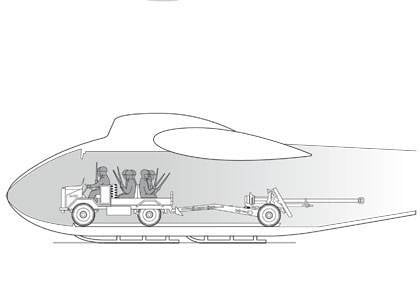
General Aircraft Hamilcar (UK, 1942). One of the largest military gliders ever produced serially. Used in a number of large landing operations.
Blohm und Voss BV 40 (Germany, 1944). Unique German attempt to build a glider fighter. The diagram clearly shows the extremely uncomfortable position of the pilot. Testers complained that the neck during the flight numb monstrously. Seven trial specimens were built, but never went to the BV 40 series.
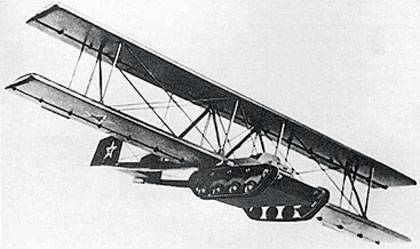
Wings of the tank. The legendary A-40 “Tank Wings”, designed by Antonov in 1941 – 1942 and even made in one copy, belonged to the original military gliders. According to Antonov, the special airframe system was “mounted” on the serial light tank T-60. During the only test flight in September 1942, almost all the gear was removed from the tank for relief purposes, but the power was still not enough. The tugboat raised the glider only on the 40 m, and the planned 160 km / h was very far away. The project is closed. By the way, the British had a similar project (Baynes Bat).
Soviet gliders
Military gliders were one of the major areas of the Soviet aircraft industry. Almost every designer had a similar project in his “portfolio”.
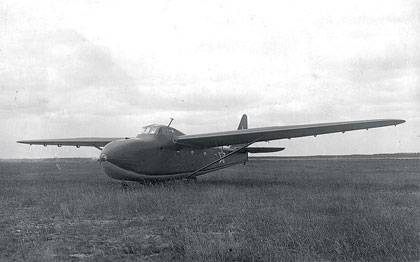
The C-25 (USSR, 1944), designed for 25 paratroopers or 2200 kg of cargo, has become a more perfect replacement for the well-known model KC-25. The main disadvantage of the latter was an unsuccessful loading system, which did not allow the full use of the airframe's load capacity. On the C-25, the nose was made flush, which greatly simplified loading.
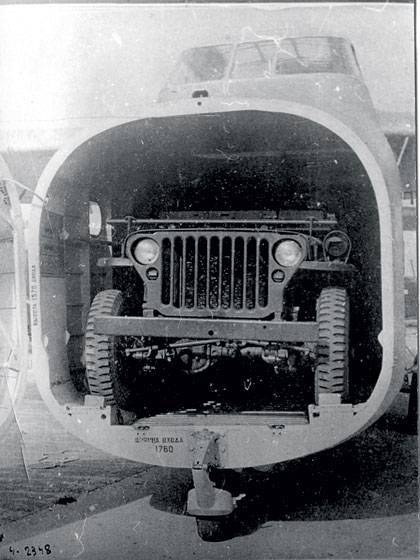
Due to the fact that the pilots were above the cargo compartment, the aerodynamics of the C-25 was worse than the competitors, but for the landing glider, the payload was the prevailing factor.
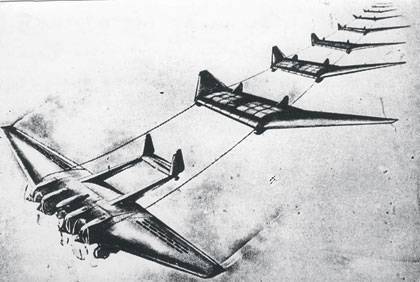
One of the original projects of Pavel Grokhovsky, known for his nontrivial thinking, is the aerostreet transport. The lead aircraft designed by Grokhovsky could tow up to ten gliders with cargo. The project was not implemented.
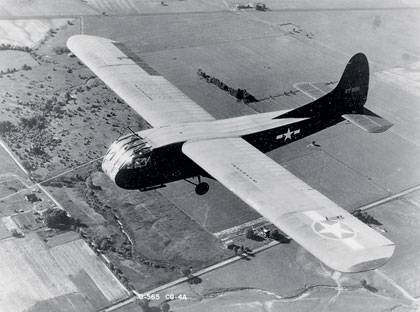
Waco CG-4A (USA, 1942). The most massive military airborne glider in the world, built almost 14 000 machines in various versions. In addition to the United States, the gliders were in service with Canada, Britain and Czechoslovakia and were widely used in various operations. The order of the 20 gliders of the Waco CG-4A has been preserved to this day.
TTX mid-size landing gliders
| Planer | T-11 | KC-20 | Gotha Go 242 | Airspeed AS.51 Horsa | Waco CG-4A |
| Country | the USSR | the USSR | Germany | United Kingdom | USA |
| Years of production | 1941 – 1948 Feet | 1941 – 1943 Feet | 1941 – 1944 Feet | 1941 – 1945 Feet | 1942 – 1945 Feet |
| Length m | 10,84 | 14,12 | 15,81 | 20,42 | 14,8 |
| Wingspan, m | 18 | 23,8 | 24,5 | 26,82 | 25,5 |
| Maximum take-off weight, kg | 1660 | - | 7300 | 7031 | 4082 |
| Capacity, people | 11 | 20 | 21 | 25 | 13 |
| Capacity, kg of cargo | - | 2200 | 2400 | - | 1900 |
| full speed planning km / h | - | - | 290 | 161 | 240 |

Information